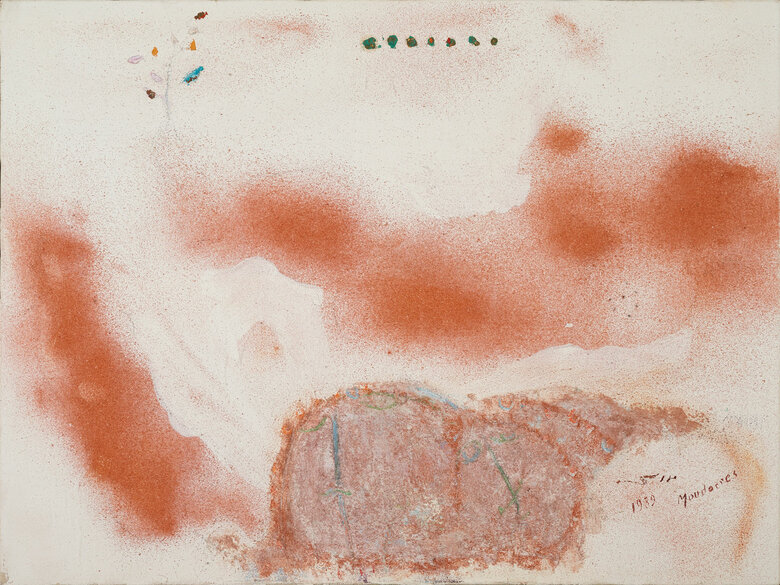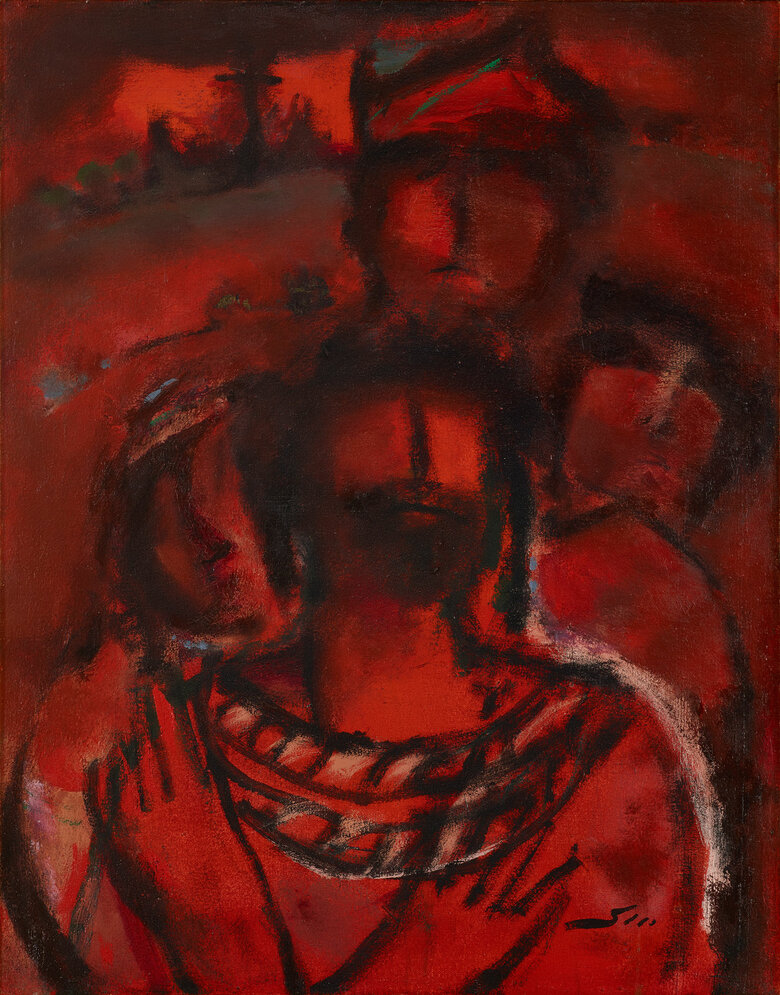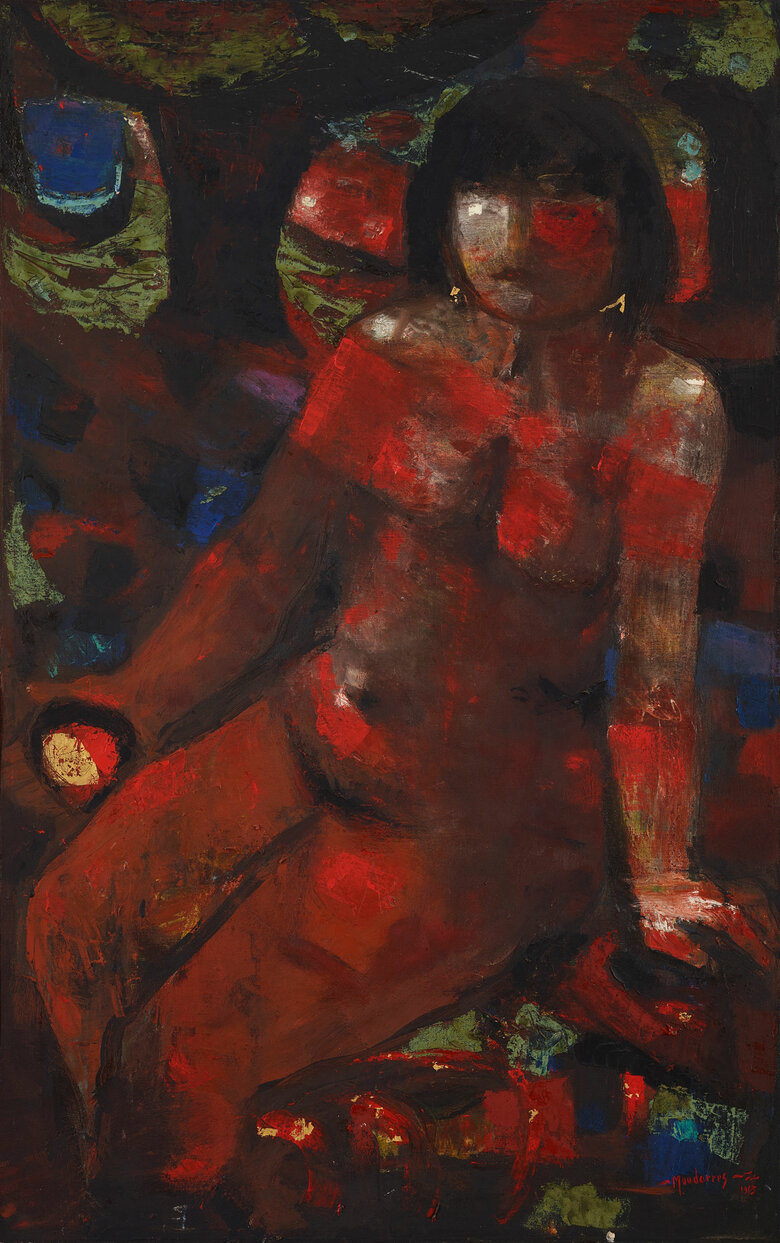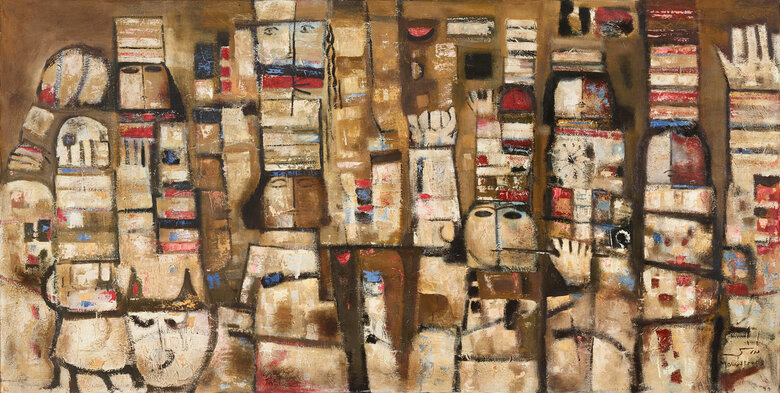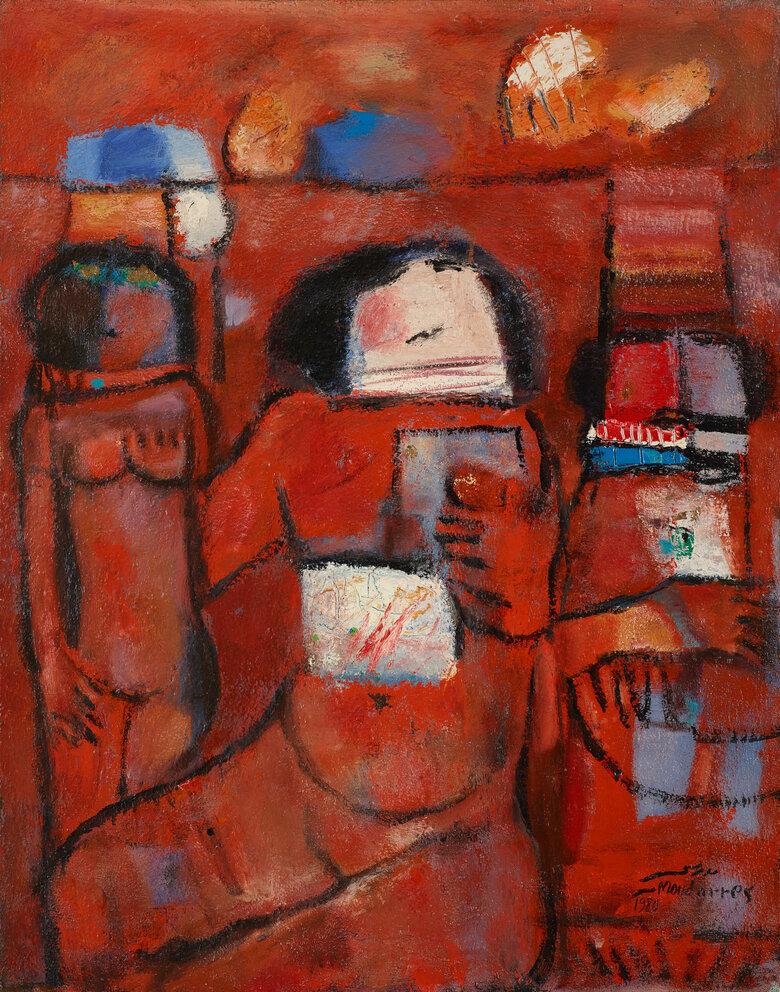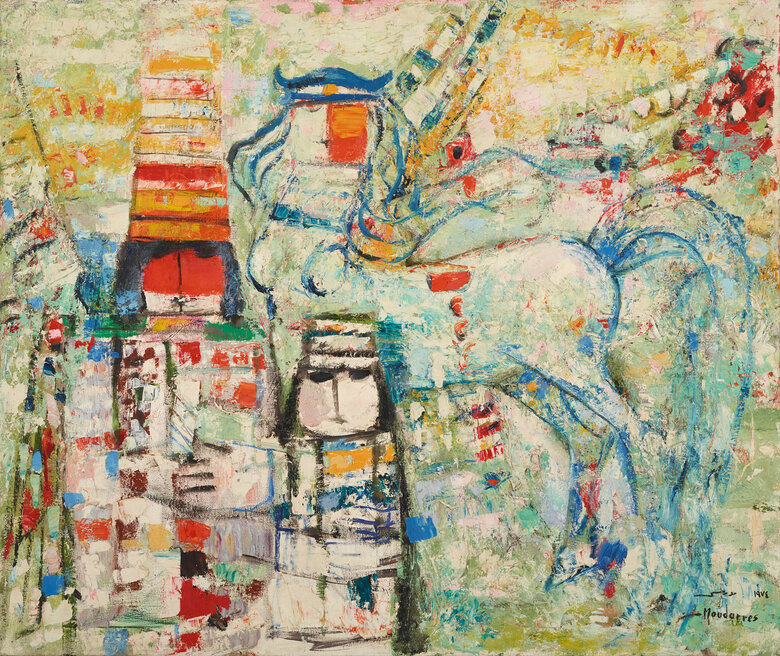A pioneering figure in the history of modern Syrian art, Fateh Moudarres was born in 1922 in a village near Aleppo. Moudarres gained recognition for his remarkable talent during his secondary...

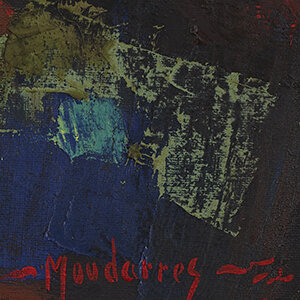
FATEH MOUDARRES, Syria (1922 - 1999)
Bio
Written by WAFA ROZ
A pioneering figure in the history of modern Syrian art, Fateh Moudarres was born in 1922 in a village near Aleppo. Moudarres gained recognition for his remarkable talent during his secondary education at the Aleppo American College, from which he graduated in 1940. From 1956 to 1960, he earned a bachelor’s degree at the Academia Di Belle Arti in Rome, later pursuing graduate studies at the École Supérieure des Beaux-Arts in Paris (1969 -1972). Upon his return to Syria, he taught at the University of Damascus, where he headed the Department of Fine Arts and became the Dean of Fine Arts Association, until 1993. Throughout his life, he continued to develop his skills under the tutelage of Wahbi Al Hariri (1914-1994), his mentor and lifelong friend, who introduced him to fellow artist Louay Kayali. Moudarres and Kayali represented Syria together in the 1961 Venice Biennale.
Self-taught at an early age, he focused on learning realist techniques before beginning his formal education, when he took an interest in surrealism. During his education he pursued this interest and developed his skills in abstraction. Though Moudarres had already begun to tap into his cultural heritage for artistic inspiration before he even arrived in Europe, he was encouraged further in this direction by his valued teacher, Franco Gentilini (1909-1981), during his time in Italy. Drawing from Sumerian, Assyrian, and Islamic visual traditions, as well as Christian iconography, Moudarres developed a personal style marked by warm tones and plays between figuration and abstraction, transparency and solidity, becoming lighter in color and more abstract in form as his career progressed. Enthralled by the magic of nature and its limitless spectrum of hues, he painted sprawling, euphoric landscapes reminiscent of the countryside where he grew up. His figures took on flat, rectangular forms, evoking Sumerian figurines and Assyrian rulers though they depicted ordinary Syrian peasants, women such as his mother, and children, stacked next to each other in an ambiguous, depthless setting.
For many, the simplicity of Moudarres’ forms elicited “primitive,” childish connotations. This style was, however, carefully and thoughtfully developed over a lifetime; when asked if his ‘childish’ paintings could be imitated, the artist’s second wife, Shoukran, replied in the negative, exclaiming that “it took him 50 years to paint like a child!”
Moudarres was a sensitive soul who wrote, played the piano, enjoyed Sufi music, and cherished the sound of the wind. In keeping with the principles espoused by European Surrealists, he considered his subconscious as a tool for creation, using techniques such as automatic drawing to give form to repressed memories and unconscious desires. His emotionally-charged works draw from deeply personal sources, including the loss of his father at the age of four, and the untimely deaths of his two children. Influenced by the existentialist philosophy of Jean-Paul Sartre, whom he met in Europe, Moudarres acknowledged the transformative power of death and the importance of confronting it as a means of sharpening one’s relationship to life itself. He expressed feelings of distress and abandonment in works depicting crucifixion, martyrdom, and mythology. The artist also believed that by mastering the art of effective form and plasticity of color, he could essentially “reinvent time,” manipulating the temporal dimension in a painting. Though much of his work draws from the personal subject matter, it also addresses humanitarian and socio-political issues that surrounded the artist, specifically after he moved to Damascus following the agricultural crisis of 1960. His societal critique usually takes the form of the symbolic, expressed through animals; the horse, the beast, and the cat, for example, appear in his paintings to represent the hero, the tyrant, and temptation.
Moudarres’s paintings are texturally rich, alternately using dense applications of oil paint, often mixed with sand and applied with scratchy brush strokes, and loose, gestural applications of thinned paint evocative of watercolor. Color, however, is the most distinctive element of Moudarres’s visual language. He related himself to Van Gogh in his dedication to the natural harmony of color. Van Gogh’s use of color, however, was primarily formal, drawing from Delacroix’s color theory in order to exploit principles of simultaneous and tonal contrasts, while Moudarres ascribed symbolic roles to each color he used. He considered red to be a primitive, aggressive color, which he used cautiously in politically oriented paintings due to its associations with battle and bloodshed. “Despite its power, I use red with kindness, and I often soften it with strokes of black or gold to overpower its strength,” the artist explained in a documentary produced in the late 1990s. Specific colors purportedly frightened or offended the artist; in the same documentary, he referred to Verona Green as a “whorish color,” one that “screams like an eggplant vendor on the streets!” He saw blue as a noble, witty color that served best in political critique; gold – often applied in gold leaf – as symbolic of Byzantine art and useful in containing or negating the dominance of other colors; white as a color of majesty, a generous host to the other hues on his canvas.
Moudarres passed away at the age of 77, in 1999.
Sources
Farhat, Maymanah.” A creative Upsurge; Syrian Art Today (Part One). “Jadaliyya Web. http://www.jadaliyya.com/pages/index/17815/a-creative-upsurge%3B-syrian-art-today-(part-one) (accessed October 3,2017).
Barjeel Art FoundationWeb. http://www.barjeelartfoundatio... (accessed October 3,2017)
“Post War at Haus der Kunst” hausderkunst Web.http://postwar.hausderkunst.de... (accessed October 3,2017)
Munif, Abdulrahman. “Fateh Al Moudares, Syrian Artist Who Fought for Justice with Brush, Pen.” Aljadid Web.http://www.aljadid.com/content... (accessed October 3,2017)
Bekhrad, Joubin. “Finding Fateh” reorientmagWeb.http://www.reorientmag.com/201... (accessed October 3,2017)
Christies, “International Modern and Contemporary Art 26 October 2010, Dubai” Artists Christies Web http://www.christies.com/LotFi... October 3,2017)
“Dr. Abed Ismael: Fateh Moudarres, Musician of Colors (English)”hdkeeps video.http://hdkeep.com/video/Fateh-... 10 secs, Uploader: Jahez Media
“Fateh Al Moudarres-فاتح المدرس”hdkeeps video. http://hdkeep.com/video/Fateh-...
6min,40sec, Uploader: b4Dubai
Moudarres, Fateh, and Adonis. Fateh and Adonis, Hewar. Atassi Foundation publications, 2009.
CV
Selected Solo Exhibitions
2018
Fateh al-Moudarres: Colour, extensity and sense, Mathaf, Arab Museum of Modern Art, Doha, Qatar
He held many solo exhibitions, the first of which was in Aleppo, then in Sweden, New York, Rome, Munich, Paris, Beirut, and Dubai.
Selected Group Exhibitions
2024
Arab Presences: Modern Art And Decolonisation: Paris 1908-1988, Musée d'Art Moderne de Paris, Paris, France
2023
Beirut And The Golden Sixties: A Manifesto Of Fragility, Mathaf, Arab Museum of Modern Art, Doha, Qatar
In the Heart of Another Country: The Diasporic Imagination Rises, Sharjah Art Foundation, Sharjah, United Arab Emirates
Partisans of the Nude: An Arab Art Genre in an Era of Contest, 1920-1960, Wallach Art Gallery, Columbia University, Harlem, New York, USA
UNTITLED Abstractions, Dalloul Art Foundation, Beirut, Lebanon
2022
Manifesto of Fragility: Beirut and The Golden Sixties, Lyon Museum of Contemporary Art, Lyon, France
In The Heart Of Another Country, Deichtorhallen, Hamburg, Germany
2021
Leads & Artistic Cues from the Arab World, Dalloul Art Foundation, Beirut, Lebanon
2019
(Nothing But) Flowers, Saleh Barakat Gallery, Beirut, Lebanon
2018
Revolution generations, Mathaf, Arab Museum of Modern Art, Doha, Qatar
A Century in Flux, Sharjah Art Museum, Sharjah, UAE
2017
Night was paper and we were ink, Sharjah Art Museum, Sharjah, UAE
2016
The Short Century, Sharjah Museum, Sharjah, UAE
2014
Works on Paper: Hikayat, Green Art Gallery, Dubai, United Arab Emirates
Sky Over The East, Emirates Palace, UAE
2013
Tajreed, CAP Kuwait, Kuwait
RE: Orient, Barjeel Art Foundation, Sharjah, UAE
1994
Retrospective of his work, L’Institut du Monde Arabe, Paris in 1995.
1986
Cairo Biennial
1980
Seoul Biennial,
1975
New York International Art Fair,
1964
Contemporary Arab Art Exhibition, Grand Palais, Paris,
1963
Sao Paulo Biennale, was granted a Medal of Honor
1961
Venice Biennial
Moudarres has also written several collections of poetry and short stories
Collections
Mathaf, Doha, Qatar
Jordanian National Gallery of Fine Art, Amman , Jordan
Khalid Shoman Collection, Amman, Jordan
Atassi Foundation, UAE
Barjeel Art Foundation, Sharjah, UAE
Ramzi and Saeda Dalloul Art Foundation, Beirut, Lebanon
Nabu Museum, Heri, Lebanon
Al-Hariri Family Currently the largest private collection of the works of Fateh Moudarres is kept by Mokhless Al-Hariri, son of Syrian artist, Wahbi Al-Hariri of The Al-Hariri Family.
The Collection of Rudolf and Maria Fechter Dr. Rudolf Fechter, a German diplomat and statesman, was also a friend of Moudarres and bought several pieces; arguably it was the second major collection of the artist's work before slowly being auctioned recently at Christie's.
Moudarres’ works were shown in the embassy rooms in Damascus, Adis Ababa and Dublin.
The Collection of Walter Scheel, former Foreign Affairs Minister of Germany, and later President,was exposed to Moudarres's work through Dr. Fechter and, an avid collector, acquired several pieces and maintains a small but sizeable collection.
Press
الأربعاء القادم_ معرض الذاكرة والوفاء بصالة إيبلا للفنون - اكتشف سورية.pdf
zamanalwsl.net.pdf
أدونيس يوقع كتاب «حوار_ فاتح وأدونيس» - اكتشف سورية.pdf
فاتح المدرس يمحو أميّة الفن.pdf
جمر تحت الرماد_ كتاب يتناول إبداع المدرس للكاتب محمد قجة - اكتشف سورية.pdf
مرحبا بكم في موقع جريدة الأتحاد _.pdf.pdf
فاتح المدرس في ذكراه الرابعة عشرة..ريادة تعبيرية مشبعة بألوان الأرض والتاريخ.pdf
فاتح المدرّس_ عراف الزمن الأعمى.pdf
Fateh al-Moudarres-Bio- Mathaf.pdf
لوحات تنبض بالحياة.. فاتح المدرس_ «أرسم لأُدرِك من أنا» - اكتشف سورية.pdf
syr_res_1460.pdf
لقاء غير منشور بين الفنان فاتح المدرس والشاعر أدونيس الجمل بما حمل نضع أخبار العالم بين يديك ونأتيك بـ الجمل بى aljaml.com.pdf
في الذكرى التاسعة لرحيل الفنان فاتح المدرس الجمل بما حمل نضع أخبار العالم بين يديك ونأتيك بـ ى aljaml.com.pdf
فاتح المدرس_ قيصر التشكيل السوري و كسر حواجز العزلة في دوائرها الزمنية.pdf
الفنان الراحل فاتح المدرس الجماهير.pdf
Fateh Moudarres_AlArabbuFarouk Youssif_Press.pdf
لوحات تنبض بالحياة.. فاتح المدرس_ «أرسم لأُدرِك من أنا».pdf
فاتح المدرس.. وحوش دخلت إلى اللوحة ولم تغادرها.pdf
reorientmag.com-Finding Fateh.pdf
لؤي كيالي وصفوان داحول وفاتح المدرّس أغلى رجال البورصة الفنية في الاقتصادي.pdf
فاتح المدرس فنان عالمي - عالم نوح.pdf
فاتح المدرّس.. الفنان والأديب وصانع الهويّة السورية.pdf
Fateh Al-Moudarres, Syrian Artist Who Fought for Justice with Brush, Pen _ Al Jadid.pdf
مرحبا بكم في موقع جريدة الأتحاد _.pdf
لقاء غير منشور بين الفنان فاتح المدرس والشاعر أدونيس الجمل بما حمل نضع أخبار العالم بين يديك ونأتيك بـ الجمل بى aljaml.com.pdf
لؤي كيالي وصفوان داحول وفاتح المدرّس أغلى رجال البورصة الفنية في الاقتصادي.pdf
الفنان الراحل فاتح المدرس الجماهير.pdf
فاتح المدرس بوابة الفن التشكيلي السوري إلى العالمية _ _ صحيفة العرب.pdf
المدن - فاتح المدرس في ذكراه_ عن لقاء الأسد وثياب البالة.pdf
فاتح المدرس فنان عالمي - عالم نوح.pdf
فاتح المدرّس.. الفنان والأديب وصانع الهويّة السورية.pdf
فاتح المدرس.. وحوش دخلت إلى اللوحة ولم تغادرها.pdf
لؤي كيالي وصفوان داحول وفاتح المدرّس أغلى رجال البورصة الفنية في الاقتصادي.pdf
لقاء غير منشور بين الفنان فاتح المدرس والشاعر أدونيس الجمل بما حمل نضع أخبار العالم بين يديك ونأتيك بـ الجمل بى aljaml.com.pdf
FATEH MOUDARRES Artwork
Become a Member
Join us in our endless discovery of modern and contemporary Arab art
Become a Member
Get updates from DAF
Follow Artists
Save your favourite Artworks
Share your perspectives on Artworks
Be part of our community
It's Free!
We value your privacy
TermsCookiesPrivacy Policies
Become a Member
Get updates from DAF
Follow Artists
Save your favourite Artworks
Share your perspectives on Artworks
Be part of our community
It's Free!
We value your privacy
TermsCookiesPrivacy Policies
Become a Member
Get updates from DAF
Follow Artists
Save your favourite Artworks
Share your perspectives on Artworks
Be part of our community
It's Free!
We value your privacy
TermsCookiesPrivacy Policies
Welcome to the Dalloul Art Foundation
Thank you for joining our community
If you have entered your email to become a member of the Dalloul Art Foundation, please click the button below to confirm your email and agree to our Terms, Cookie & Privacy policies.
We value your privacy, see how
Become a Member
Get updates from DAF
Follow Artists
Save your favourite Artworks
Share your perspectives on Artworks
Be part of our community
It's Free!
We value your privacy
TermsCookiesPrivacy Policies

